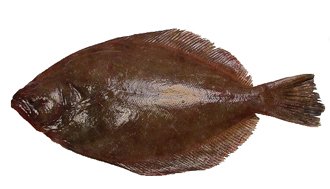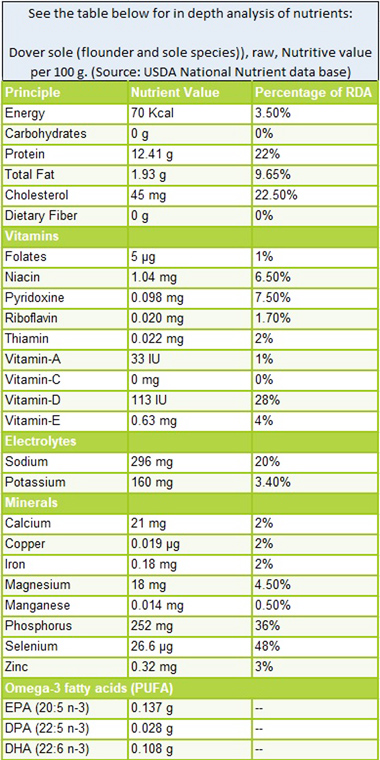Flounder Fish Nutrition Facts
Flounders are a fascinating species of flatfish found in coastal waters worldwide. Renowned for their delicate flavor and tender texture, flounder has become a culinary favorite in many cultures. From classic seafood dishes to innovative recipes, this versatile fish continues to captivate the taste buds of seafood enthusiasts.
Flounder belongs to the Pleuronectidae family, which includes various species known for their distinctive flat bodies and unique swimming behavior. Other common names for flounder include Plaice, Sole, Dab, and Fluke.
 |
| Southern Flounder. (Photo credit: SEFSC Pascagoula Laboratory; Collection of Brandi Noble, NOAA/NMFS/SEFSC.) |
Flounder Species
The notable flounder species are:
The Atlantic flounder (Paralichthys dentatus) is commonly known as summer flounder or fluke, inhabits the western Atlantic Ocean, from Canada to Florida. It is prized for its mild flavor and firm texture, making it a favorite among recreational and commercial fishermen alike.
European flounder (Platichthys flesus) is found in coastal waters from the Baltic Sea to the Mediterranean. It is esteemed for its delicate taste and versatility in culinary applications.
Description
A flounder fish is characterized by its flattened body, which allows it to camouflage itself on the ocean floor. With both eyes positioned on one side of its head, flounder has a remarkable ability to blend into its surroundings, making it a proficient predator. It typically ranges in size from small to medium, with variations depending on the specific species.
Flounder can be identified by its diamond-shaped body, mottled brown or green coloration, and distinctive eyes. Like other flatfish, flounder swims sideways and has a unique asymmetrical appearance.
Habitat and Biology
Flounder is a demersal fish, meaning it resides on or near the ocean floor. It inhabits a variety of coastal environments, including sandy bottoms, mud flats, and rocky reefs. Flounder is known for its adaptability, thriving in both shallow and deep waters.
Flounder feeds on a diet of small fish, crustaceans, and marine invertebrates. Its hunting strategy involves lying in wait for prey to pass by, then ambushing with a swift strike. This predatory behavior, combined with its camouflage abilities, makes flounder a formidable predator in its ecosystem.
Health Benefits of Flounder Fish
Flounder is a lean, protein-rich fish, making it an excellent choice for health-conscious individuals. With only 70 calories per 100 grams, flounder is a low-calorie option compared to other protein sources.
It is a rich source of essential nutrients, including omega-3 fatty acids, vitamins, and minerals. Flounder provides a well-rounded nutritional profile, contributing to overall health and well-being.
Flounder offers high-quality protein with all essential amino acids, promoting muscle growth, repair, and maintenance. With approximately 13 grams of protein per 100 grams of fish, flounder is a satisfying and nutritious addition to any diet.
Its omega-3 fatty acids, including EPA and DHA, support heart health, brain function, and inflammation regulation. Regular consumption of flounder may reduce the risk of cardiovascular disease and improve cognitive function.
In adults, studies like the "GISSI Prevention Trial have shown that daily intake of omega-3 fats can reduce the likelihood of recurrent heart attacks, strokes, or sudden death, compared to a placebo.
Flounder is a low-mercury fish, making it a safe choice for pregnant women and young children. The U.S. FDA recommends consuming 2-3 servings of low-mercury fish per week as part of a healthy diet.
Research from Cornell University and the New York Sea Grant Extension Program- 2012- suggests that omega-3 fatty acids found in flounder may have anti-inflammatory properties, benefiting individuals with conditions such as arthritis, asthma, and inflammatory bowel disease.
Flounder contains essential vitamins, including vitamin D, vitamin B12, and vitamin A, which play key roles in immune function, bone health, and vision.
Its mineral content, including potassium, phosphorus, and selenium, supports various physiological functions, such as electrolyte balance, bone formation, and antioxidant defense.
Flounder is a sustainable seafood choice, with many fisheries implementing responsible harvesting practices to protect marine ecosystems and ensure long-term viability.
Buying
Flounder is readily available year-round, with fresh and frozen options widely accessible in seafood markets and grocery stores. When purchasing flounder, look for firm, moist flesh with a mild, briny aroma, indicating freshness.
Choose filleted flounder for convenience and ease of preparation. Fresh flounder should have clear, bright eyes and shiny, metallic skin. Avoid fish with dull, sunken eyes or strong fishy odors, as these may indicate poor quality or spoilage.
Store fresh flounder in the refrigerator for up to two days, or freeze for longer-term storage. Properly wrapped and sealed, frozen flounder can last for several months without compromising quality.
Preparation and Serving Methods
Flounder lends itself to a variety of cooking techniques, including baking, grilling, broiling, and sautéing. Its delicate flavor pairs well with a range of seasonings and sauces, allowing for endless culinary creativity.
Here are some serving methods
 |
| Dover sole meniure. Photo credit: Ralph Daily |
Try pan-searing flounder fillets with a simple lemon-butter sauce for a quick and flavorful meal. Alternatively, bake flounder with herbs and spices for a healthy and delicious entree.
For a classic preparation, consider stuffing whole flounder with a savory seafood filling and baking until golden brown. Serve with fresh vegetables and a squeeze of lemon for a delightful dining experience.
Flounder is also a popular choice for fish tacos, fish sandwiches, and seafood salads, adding a light and refreshing touch to any dish.
Safety profile
Flounder sourced from sustainable fisheries is considered a responsible choice for environmentally conscious consumers. Look for certifications such as Marine Stewardship Council (MSC) or Best Aquaculture Practices (BAP) to ensure ethical and sustainable sourcing.
Flounder may contain trace amounts of environmental contaminants, including mercury and polychlorinated biphenyls (PCBs). However, these levels are typically low and pose minimal risk to human health, especially when consumed in moderation.
As with any seafood, individuals with allergies or sensitivities should exercise caution when consuming flounder and consult with a healthcare provider if necessary.
Also read ≻≻-
≺≺- Mercury in Fish: Health Benefits, Risks, and Safe Choices
≺≺- Dover Sole nutrition facts and health benefits.
≺≺- Branzino (European sea bass) nutrition facts and health benefits.
≺≺- Halibut nutrition facts and health benefits.
≺≺- Trout fish nutrition facts and health benefits.
≻≻-Back to Seafood from Flounder Fish nutrition facts and health benefits.
Further reading (Links opens in new window):
Seafood guide -PDF.
Omega-3 Fatty Acids: An Essential Contribution.
